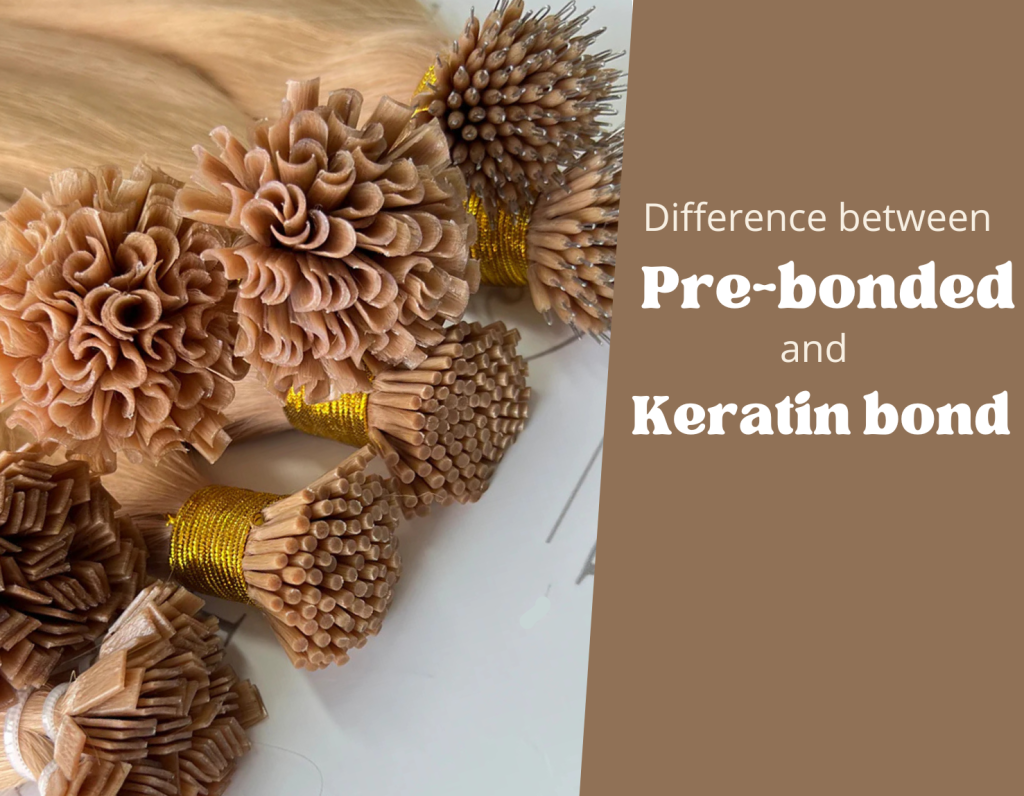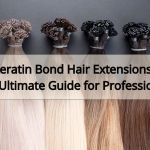Hair Knowledge
Pre-Bonded vs. Keratin Bond Hair Extensions: What’s the Difference?
I. Introduction: Why This Distinction Matters
In the world of semi-permanent hair extensions, pre-bonded and keratin bond are often used interchangeably. While closely related, they are not exactly the same. Misunderstanding these terms can lead to confusion when choosing the right method for your clients or your own hair extension routine.
In this article, we’ll clarify what each term truly means, how they overlap, and—most importantly—how they differ. Whether you’re a salon owner or a savvy end-user, this guide will help you make better, more informed decisions.
II. What Are Pre-Bonded Hair Extensions?
Definition
Pre-bonded hair extensions refer to any type of hair extension that comes with a pre-applied adhesive tip—meaning the bonding agent is already attached at the factory. These extensions are typically installed strand-by-strand using heat, pressure, or micro-rings.
The key point: “Pre-bonded” describes the way the extension is manufactured—not the material or method used to apply it.
Common Bond Types Used in Pre-Bonded Extensions
- Keratin polymer (most common)
- Resin (soft bond)
- Thermoplastic polyurethane (PU)
- Silicone-infused adhesive
- Polymer-based gel tips
Application Methods for Pre-Bonded Extensions
Hot Fusion
Uses heat to melt the bond (typically keratin or hot-melt polymer), fusing the extension to the natural hair.
→ Common with U-tip, V-tip, Flat-tip extensions.
Cold Fusion
Involves no heat. Attachment is achieved through:
- Soft gel or resin bonds activated by pressure or ultrasonic vibration.
- Nano rings or micro rings, using a metal or silicone bead to secure the bonded tip
“Pre-bonded” simply means the extension comes pre-tipped with an adhesive—the bond may be keratin, polymer, resin, or other materials, and it can be installed via heat, pressure, or micro-ring systems.
This distinction is especially important for professionals selecting the right extension method based on hair type, scalp sensitivity, and desired wear time.
III. What Are Keratin Bond Hair Extensions?
Definition
Keratin bond hair extensions are a subcategory of pre-bonded extensions in which the bonding material is keratin—a specialized polymer adhesive often (but not always) derived from synthetic keratin.
The keratin is pre-applied to the tip of each strand and activated using either heat (hot fusion) or pressure (cold fusion). When melted or softened, the keratin bond wraps around a section of natural hair to create a secure, nearly invisible connection.
Key Characteristics
- Pre-tipped with keratin-based glue
- Applied using a fusion tool or ultrasonic applicator
- Offers a discreet, flat bond
- Highly durable (6–12 weeks wear time)
⚠️ Note: Despite the name, the “keratin” in keratin bonds is not the same protein found in human hair—it’s a specially engineered adhesive for cosmetic use.
IV. Pre-Bonded vs. Keratin Bond: What’s the Real Difference?
Here’s a direct comparison to help clarify the overlap and distinctions:
| Feature | Pre-Bonded Extensions | Keratin Bond Extensions |
|---|---|---|
| Definition | Any hair extension with a pre-applied bond at the tip | Pre-bonded hair extensions that specifically use keratin |
| Bond material | Can be keratin, resin, polymer, silicone | Exclusively keratin-based |
| Application methods | Hot fusion, cold fusion, or micro ring | Hot or cold fusion only |
| Examples | U-tip, I-tip, nano ring, V-tip, flat-tip | U-tip, V-tip, flat keratin bond, ultrasonic fusion |
| Reusable | Depends on bond type (I-tip: reusable; keratin: semi-permanent) | Mostly semi-permanent; limited reuse |
| Ideal for | All hair types, depending on method | Medium-thick hair, clients wanting long-term solutions |
V. So, Is Keratin Bond a Type of Pre-Bonded Extension?
Yes. Keratin bond extensions fall under the umbrella of pre-bonded extensions because the keratin is pre-attached to the hair strand before installation.
However, not all pre-bonded extensions are keratin-based. For instance:
- I-tip extensions may use polymer tips instead of keratin.
- Cold fusion nano tips often use soft resin instead of heat-activated glue.
- Ultrasonic bonds use cold-activated materials for sensitive hair types.
VI. Choosing the Right One for Your Clients
Use Keratin Bond Extensions If:
- Your client wants long-lasting, semi-permanent wear
- They have healthy, medium to thick hair
- They want a discreet, flexible finish
- You’re offering high-end salon installation
Use Other Pre-Bonded Types (Non-Keratin) If:
- Client has fine or fragile hair
- Heat-based methods are not recommended
- They prefer cold fusion or reusable solutions
- You want more customization in bond type and size
Final Thoughts
In short, pre-bonded hair extensions describe a category, while keratin bond extensions are a specific type within that category.
Understanding the distinction is especially important if you’re working in a professional salon or purchasing for long-term use. The bonding material and method of application can affect not only comfort and wear time but also the health of the client’s natural hair.
✨ At N Hair Factory, we offer a range of pre-bonded solutions—from premium keratin flat-tip extensions to cold-fusion-friendly I-tip and nano tip systems—crafted for European salon professionals.





